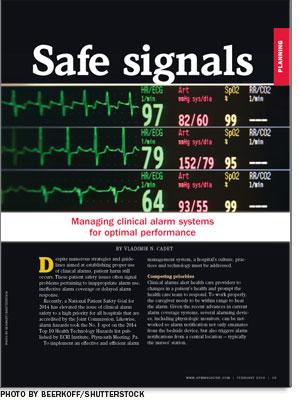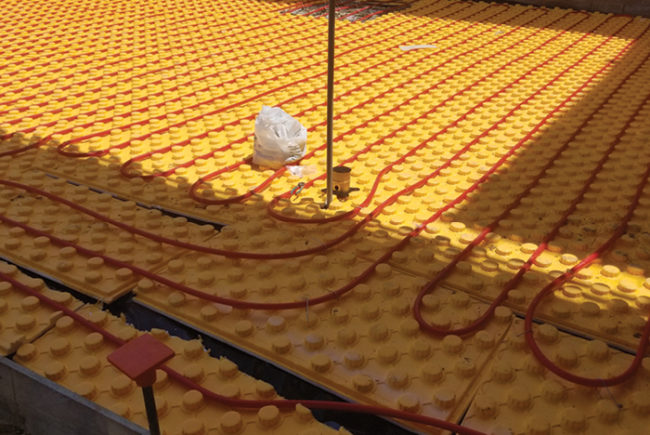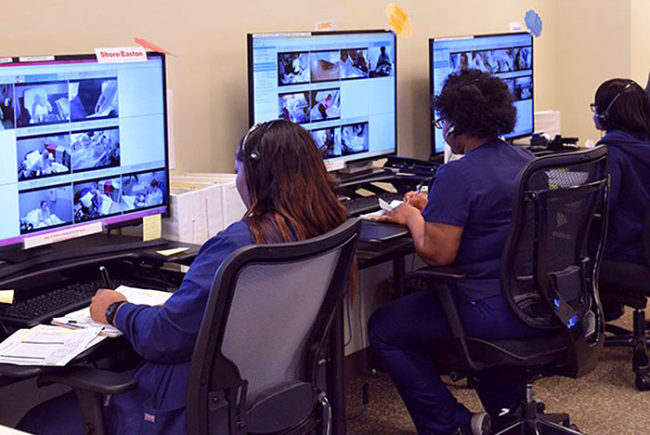 Despite numerous strategies and guidelines aimed at establishing proper use of clinical alarms, patient harm still occurs. These patient safety issues often signal problems pertaining to inappropriate alarm use, ineffective alarm coverage or delayed alarm response.
Despite numerous strategies and guidelines aimed at establishing proper use of clinical alarms, patient harm still occurs. These patient safety issues often signal problems pertaining to inappropriate alarm use, ineffective alarm coverage or delayed alarm response.
Recently, a National Patient Safety Goal for 2014 has elevated the issue of clinical alarm safety to a high priority for all hospitals that are accredited by the Joint Commission. Likewise, alarm hazards took the No. 1 spot on the 2014 Top 10 Health Technology Hazards list published by ECRI Institute, Plymouth Meeting, Pa.
To implement an effective and efficient alarm management system, a hospital's culture, practices and technology must be addressed.
Competing priorities
Clinical alarms alert health care providers to changes in a patient's health and prompt the health care team to respond. To work properly, the caregiver needs to be within range to hear the alarm. Given the recent advances in current alarm coverage systems, several alarming devices, including physiologic monitors, can be networked so alarm notification not only emanates from the bedside device, but also triggers alarm notifications from a central location — typically the nurses' station.
Other enhancements include enunciators that provide audible alarms in locations where it may be difficult to hear device alarms and remote displays in strategic locations that mirror the central station display.
Each hospital faces competing budget, time and resource constraints that can become barriers to addressing alarm issues. These factors can particularly hinder changes that could improve alarm coverage strategies and reduce alarm fatigue. Therefore, addressing alarm management issues appropriately demands a multidisciplinary team approach with special focus on planning, design and implementation.
Gathering input from key stakeholders during the initial stages of alarm management planning for new or existing hospitals and units is essential to building optimal alarm coverage models and reducing safety issues such as alarm fatigue and missed events.
Internal hospital stakeholders can include representatives from the areas of health facilities, nursing, clinical engineering, clinician champions, executives and information technology (IT). If incorporating an alarm integration staff, it will be important to include external stakeholders such as medical device vendors and manufacturers that design the middleware capable of capturing and propagating information to health care devices.
Other external stakeholders may include architects tasked with building or renovating hospital buildings and units.
The role of facilities and IT leaders in the planning process cannot be overlooked, because they will be responsible for ensuring that hospital units will have the wiring for alarm integration systems. For example, IT will need to run cabling conduits for these systems. During the planning process, it may be advisable to run conduits everywhere possible and ensure that cables are wired for video, power or network, and located in the hallways, walls and ceilings for devices such as enunciators, remote display monitors and wireless access points.
While this might seem like a financial inconvenience, long-term savings can be anticipated because most hospitals want to expand unit capabilities. Having to install cabling after the physical structure has been set in place can be expensive. Facilities departmental leaders even will be responsible for ensuring structural capabilities, including proper hallway backings to sustain or support display monitors. Communication between facilities and all staff will be essential to ensure optimal alarm management structure and processes.
Improvement framework
Infrastructure provides the framework for alarm management improvement. It refers to elements like architectural layout, staffing patterns and care models, alarm coverage models and policies currently in place. Architectural layout includes the actual physical design and structure of the hospital's units, such as patient rooms, nursing stations and hallway layouts. Staffing pattern reviews consider and address the depth of experience or capabilities of nurse providers and their capacity to provide effective care in each hospital unit.
Alarm coverage models refer to the manner in which clinical staff monitor patients within the unit. These can be centralized or decentralized. In the typical decentralized model, nurses rely on direct alarm notification from central station displays or remote displays. Another decentralized model uses unit-based monitor technicians to watch central station displays and provide alarm notification to nurses; however, use of monitor technicians is less common because of the associated cost.
Many hospitals are implementing remote centralized monitoring surveillance rooms as a way to manage clinical alarms better. These rooms house technicians who continuously monitor central station displays from multiple care areas and provide alarm notification to nurses via phones or pagers.
Alternatively, an increasing number of hospitals are considering alarm integration systems for ancillary alarm notification. These systems transmit designated clinical device alarms to the alarm integration system and then to the appropriate caregivers via clinician-worn communication devices, such as pagers or wireless phones. Each alarm coverage model has its advantages and challenges, but thorough planning is the key to the success of each. Policies include the plan or course of action established to ensure appropriate and consistent alarm response and coverage.
Each hospital's alarm system must be customized to the specific area's workflow to effectively enhance alarm notification and facilitate prompt alarm response. Because of this, hospitals must take a deep look at their care areas and alarm management practices as well as their culture and technology. Facilities professionals especially need to be involved in solutions related to infrastructure, because this has a dynamic relationship with other related factors in improving a hospital's alarm management system.
For example, what happens to clinical alarm response protocols or escalation plans in a 36-bed intensive care unit supersized for patient privacy, quiet and family comfort? Modern hospital floor plans include emphasis on patient and family privacy, quiet environment and larger size area, all designed to improve patient healing and comfort. Although well-intentioned, these trends present many new alarm management challenges, and the old ways of alarm notification and response do not work.
Key factors
Properly addressing the following key factors pertaining to alarm management infrastructure significantly can improve the efficacy and efficiency of alarm management systems:
Architectural layout. Hospital physical layouts can unwittingly create inefficiencies, often fatiguing responding nurses and creating unnecessary or confusing coverage plans. It is important to limit the size of care areas within larger hospital units so that nursing staff, while maintaining an acceptable distance from patient rooms, can still physically observe and hear alarms. Creating smaller areas within these larger units also will help nurses to respond more promptly to clinical alarms.
The planning and design team may consider establishing unit zones based on current floor designs. For instance, architectural boundaries can be established by fire doors that often can be used to differentiate zones.
Other issues include having private patient rooms with the doors closed. For example, some hospitals may require isolation room doors that close automatically in ventilation units, compromising the audibility of alarms outside in the hallways.
A strategy that may be employed to reduce missed alarms includes enunciators to increase alarm audibility. However, enunciator placement in the unit and alarm sounds emanating from the enunciator also must be taken into consideration. For example, if the speakers produce the same sound for all alarms, this could create or add to an environment of alarm fatigue for the nursing staff and lead to patient dissatisfaction due to increased noise levels.
Therefore, it will be imperative to solicit input from all stakeholders, including clinicians, nursing supervisors, clinical engineering and IT to understand device capabilities, architectural and design limitations, and to strategize accordingly to avoid these issues.
Alarm escalation and coverage plan. Often, improper alarm escalation plans can lead to alarm management inefficiencies. To reduce alarm fatigue and improve patient coverage, ECRI Institute recommends that hospitals assess whether to establish escalation plans delineated by zone.
This type of escalation plan could improve alarm response times significantly. Take this scenario, for example: The primary care nurse is prompted by an alarm. If the alarm is not addressed in a timely fashion, the alarm could then escalate to a designated nurse or buddy nurse. If the buddy nurse does not respond within a specified time, the alarm would escalate to the assigned set of nurses within the zone.
Rather than having alarms propagate to all nurses in the unit, alarms would propagate to a subset of nurses. Creating practices like this could allow for a more efficient and timely response to clinical alarms by nursing staff.
Policy revision and standardization. Policies can vary immensely between units. While some variations may be necessary based on factors such as patient acuity, others may be unnecessary and can complicate alarm management practices.
In these instances, it may be critical for hospitals to standardize transport routes to better track and locate patients in the event of device failures or lack of wireless networking. Discussing these strategies during the planning and design process could ensure proper network coverage in pertinent areas and improve the floor design to allow for efficiencies (i.e., transport routes).
Nurse staffing and communication. Proper nurse staffing ratios, staffing numbers per shift and communication within each hospital unit are essential. Establishing device inventory can help to reduce gaps and communication errors during shift changes, especially considering that some nursing staff may forget to return communication devices after shift completion. Having the appropriate number of communication devices can help all nurses promptly respond to patient alarms.
Thorough analysis
Many hospitals attempt to remedy alarm fatigue without the thorough analysis and planning that is required.
Hospitals should place emphasis on tailoring strategies to the unique context of the unit or hospital, taking into account such elements as patient population, staffing patterns and care model, architectural layout, and alarm coverage models.
A good rule of thumb is to maintain clear focus on the goal of making patient care safer by minimizing vulnerabilities, reducing risk and continually improving the effectiveness and efficiency of alarm management.
Vladimir N. Cadet is an associate in the applied solutions group at ECRI Institute, Plymouth Meeting, Pa. He can be reached at vcadet@ecri.org.
Impact of design on clinical alarm management
Hospitals are now more like hotels than patient care centers. Rooms are now naturally lit, brightly designed and geared more toward patients and families. These modern, single-patient hospital rooms are setting a new standard in terms of providing patient and family comfort, privacy and convenience.
Ultimately, this improves patient satisfaction scores, but is it threatening the efficacy and efficiency of alarm coverage models?
Nurses are now expected to cover more ground while treating patients, leading to increased nurse response times and a reduction in patient visibility. This design also has been said to burden nursing staff and reduce the audibility of alarms as well as the quality of alarm management. For facilities going to this new model of patient care units, strategies to reduce delayed alarm response must be deployed.
These strategies include:
• Place remote displays in strategic hallway locations. While patient visibility might be compromised, nurses still can monitor patient vital signs without having to travel long distances between the patient room and central nursing station.
• Install enunciators. Given the spacious floor layout, alarms from distant patient rooms may not be audible. Strategically installing enunciators can help to fix this problem.
• Create alarm zones. Creating alarm zones on floors allows designated nurses to respond to a specific section of the hospital unit.
• Consider installing an alarm escalation plan. Under this system, if a charge nurse does not respond within a specified time, the alarm will escalate to a designated nurse or group of nurses within the zone. By implementing an alarm escalation plan and only notifying the pertinent clinical staff, health care facilities can reduce overall alarm fatigue.
Costs to consider when improving clinical alarms
Establishing a multidisciplinary team during the planning and design phase of hospital building and renovation plans is an effective first step toward a safer — and potentially more economical — alarm management system.
Hospitals that want to incorporate or expand alarm management capabilities without a proper infrastructure in place have found this to be quite a costly initiative. In general, it is easier and less expensive to expand upon or upgrade equipment when proper infrastructure needs initially are considered.
The following considerations can make future alarm management systems more effective and can cost hospitals less money to implement:
• Run conduits everywhere. Running conduits throughout the entire facility, even though they will not necessarily be used right away, may seem like a financial waste. However, expansions to hospital units and technology systems are not unusual. It would be more costly to add conduits after a hospital is built than before building plans are implemented. So, be sure to run conduits to ensure that cables are wired for all possibilities and located in ceilings, hallways and walls for all devices that could be used to enhance alarm coverage.
• Ensure structural integrity. In numerous instances, expanding nurse coverage capabilities and improving response time requires applying remote display monitors in the unit hallways to improve patient monitoring. Improper backing could render this an improbability or significantly add to structural costs that could have been mitigated with proper planning.
• Test current system. Often, hospitals can implement strategies like alarm integration systems and other upgrades without testing the capacity of the system in place. It is essential for hospitals to determine whether current components are expandable or upgradeable before purchasing modern systems that may be incompatible with current cabling and wiring.
Resources on the Web
Need more information on clinical alarm infrastructure management? Try the following resources, which the author used to prepare this article:
• ECRI Institute's Alarm Safety Resource Site:www.ecri.org/forms/pages/Alarm_Safety_Resource.aspx
• Joint Commission's "R3 (requirement, rationale, reference) Report" on the National Patient Safety Goal for clinical alarms:www.jointcommission.org/standards_information/r3_report.aspx





